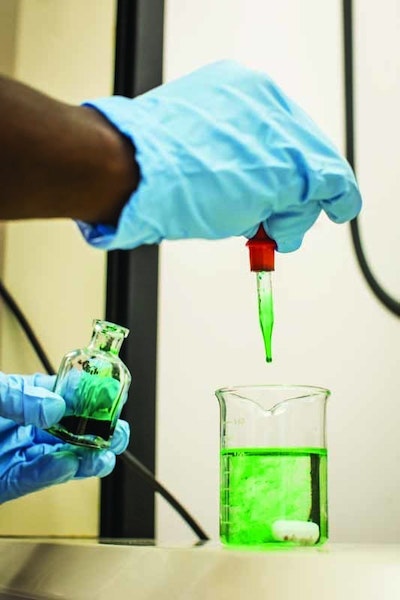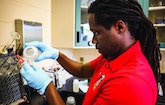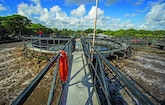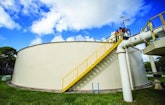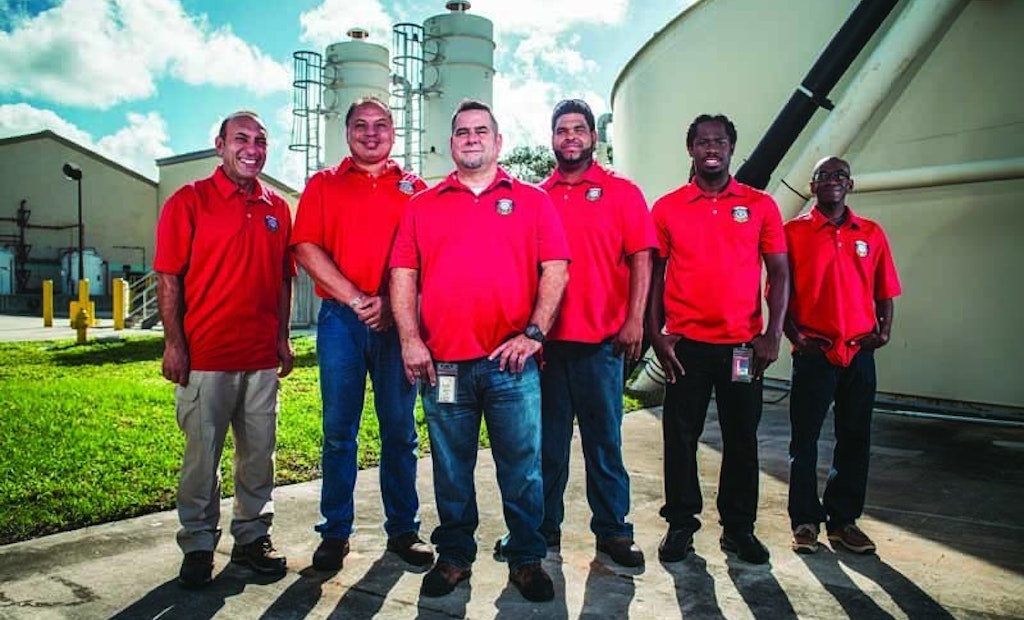
Interested in Blowers?
Get Blowers articles, news and videos right in your inbox! Sign up now.
Blowers + Get AlertsAnyone who has cruised aboard a ship homeported in Port Everglades has come within about 10 miles of the Seminole Tribe of Florida’s Hollywood Reservation water and wastewater treatment plants.
The 497-acre Hollywood Reservation is the headquarters of the Seminole Tribe of Florida and one of six Seminole reservations in the state. Sited side by side at Osceola Street and Florida Highway 7, southwest of the Fort Lauderdale-Hollywood Airport, the reverse osmosis (RO) drinking water plant supplies about 800 homes and offices. The wastewater treatment plant serves about 300 homes and a few businesses.
Together, the plants assure residents of a high-quality drinking water supply. The wastewater facility also has a commendable safety record that has been recognized with awards from the Florida Water Environment Association.
Today, both plants are undergoing upgrades and expansions to support residential and business growth. The tribe plans to expand the water treatment plant in the next three to five years. The tribe is also designing a new small-footprint 3 mgd sequencing batch reactor (SBR) wastewater reclamation plant, expected to come online in about five years.
Timing for these upgrades revolves around construction of a new deep-injection well to handle the drinking water plant’s RO brine; it is to be completed in two years. The projects are tied together because the wastewater treatment plant now discharges effluent to a percolation pond, where it is diluted by the RO brine. The diluted water then seeps slowly through the percolation pond walls, removing salts.
Rich heritage
The Seminole Tribe of Florida has about 2,000 members, with some 1,300 living on the reservations, which comprise 90,000 acres. In 1977, the tribe opened the first “smoke shop,” offering discount, tax-free tobacco products and providing a stable source of revenue. In 1981, the Seminoles became the first tribe in the United States to open a high-stakes bingo hall, in effect launching the tribal gaming industry.
Today, all Seminole tribal members are afforded modern housing and health care. Well over 300 members are employed by the tribe in governmental departments. Water Resource Management and Utilities operate under the Tribal Community Development Division. Derek Koger is director of Public Works, and Juan Mata is plant operations manager.
Day-to-day responsibility for the Hollywood water and wastewater treatment plants falls to Mario Isidron, chief operator. His team includes six operators, four certified in both water and wastewater. “We prefer dual-certified, C-or-above operators, because of the extra staffing flexibility they provide,” he says. The plants are not continuously staffed on holidays or weekends, but at least one operator visits each plant every day. A SCADA system enables operators to monitor operations and clear faults remotely.
Isidron holds a Georgia Class II Water Treatment Plant Operator license and a Florida Class C Wastewater license, in addition to a bachelor’s degree in civil engineering. The other dual-certified operators are:
- Arkie Caraballo, Florida Class B Drinking Water and Waste- water
- Andrew Mason II, Florida Class C Drinking Water and Class B Wastewater, plus a master’s degree in business administration
- Michael Judson, Florida Class C Drinking Water and Wastewater, associate degree in chemistry, and working on bachelor’s and master’s degrees in biomedical engineering
- Operator Bassem Sanaallah holds a Florida Class B Drinking Water license, and Hilberto Pacheco, with a Florida Level 3 Distribution System license, runs the distribution and collections systems, sometimes getting help on bigger jobs from a four-member tribal underground utilities team.
High standards
Mason spends most of his time at the wastewater treatment plant, a 40-year-old, 1 mgd Davco extended aeration facility (Evoqua Water Technologies). The plant is not regulated by the State of Florida, but is run as though it were. If a state regulation is more stringent than a U.S. EPA regulation, “We treat the state regulation as though it is the governing regulation,” Judson says.
“The EPA does not regulate wastewater, so any influent or effluent that does not leave the reservation is not under its jurisdiction. Therefore, we do not have an NPDES permit like most municipalities. In fact, the raw water from our wells is not regulated by the EPA either. On the reservation, the EPA focuses on the finished product. That being said, the tribe has the finest drinking water treatment that money can buy to ensure the highest standards of quality for its members.”
After a bar screen for preliminary treatment, the influent enters a long, extended-aeration treatment run, after which it is chlorinated and discharged to the percolation pond.
“Eventually, some of the water recharges the aquifer, but not until it has passed through several layers and feet of sand and other natural rock formations that make up this area’s geology,” Judson says.
Biosolids are dewatered using a belt filter press (VFOLD). The dewatered material is collected with solids from other Seminole Tribe treatment plants and goes to a landfill. Solids from the new wastewater plant will be managed in the same way.
When the new 3 mgd (peak flow) SBR plant comes online, “It will produce a non-potable reuse effluent,” Isidron says. Its reclaimed effluent will irrigate tribal area landscaping and will take some pressure off the drinking water plant. The plant is now at the 60 percent design stage; Hazen and Sawyer is the consulting engineering firm. Isidron notes that the
Hollywood operators attend design meetings and work with the engineers in the design process: “At some plants, only the lead operators go to those meetings. Here, we all do.”
Advanced practices
The reservation draws its drinking water from three 125-foot-deep wells; two more wells are under construction. The source water is filtered through a 1-micron cartridge prefilter, then conditioned with sulfuric acid and anti-scalant. The wells are flushed regularly.
“The water from these wells is high in iron that would plate out on the RO membranes without the pretreatment,” Judson says. “Treating it helps it pass through and prevent hardness fouling.” The team has developed operating practices for the 3 mgd plant that reduce membrane cleanings from three times per year to once every three years or longer.
Judson says the sulfuric acid and anti-scalant used in the pre-treatment stage lets them adjust the source water pH to 5.8 instead of the 6.5 initially recommended by the plant designers. They also flush all RO skids (Aerex Industries) with permeate water every day instead of just the skids used on that day. These actions prevent fouling and extend the time between cleanings.
The water goes from preconditioning to the low-pressure RO system (Toray Membrane USA), which removes salts and softens the water. The permeate water is filtered twice, and the RO stage also removes biologics such as bacteria and viruses. The RO system has an 85 percent recovery rate.
Follow-up treatment includes degassing to remove hydrogen sulfide and other gases. Then the water is chlorinated and treated with a custom-designed corrosion inhibitor (American Water Chemicals) and additional chemicals are added to raise the pH to 8.2 to reduce rust formation in the distribution system. Finished water is stored in a 1.5-million-gallon clearwell before distribution. “Our RO process removes 99.99 percent of undesirable materials,” Judson says.
The percolation pond where RO brine is discharged functions as “nature’s filter,” Judson says. When the new wastewater treatment plant goes online and its effluent is reused, the RO brine will be injected into a deep well.
Priority on safety
The Hollywood Reservation has a lab on site for routine testing. “On a schedule, the EPA gives us a list of what to test for,” says Judson. “As a small distribution system, we test every month for Bac-T and total coliforms.” The tribe puts out a consumer confidence report annually and tests the source wells monthly. Judson notes that saltwater intrusion into groundwater is forcing more Florida drinking water plants to move to RO. He’s happy to share with others the operating practices his team has developed.
While safe water is a top priority, so is personnel safety. The Hollywood wastewater plant won a second-place safety award in 2014 and a first-place award in 2015 from the Florida Water Environment Association. The tribe’s Public Works safety officer, John Holdman, helps the Hollywood team with its safety program.
The staff has regular “Safety Thursday” sit-down meetings and discussions covering topics from electrical and chemical-handling safety to proper lifting and back health. An attendance log is taken. Each operator has a “safety bag” containing personal protective equipment. “We take safety seriously — it’s a team effort,” Judson says.
The tribe also has an Emergency Management Division that is part of its police department. Any time a hurricane might be headed toward the reservation, the operators and the Emergency Management Division get together to discuss preparations. Public Works transfer station crews fan out through the reservation to pick up trash and objects that could become missile hazards. They also distribute information to remind residents how they should prepare: securing loose items; boarding up windows; readying flashlights, radios and batteries; and having bottled water and nonperishable food on hand.
The water and wastewater treatment plants have standby generators; the wells and lift stations have portable generators. The plants have generators and chain saws for loan to tribal members, and make ice from their ice machine available to those who need it.
Reaching out
The Hollywood water and wastewater plant teams put substantial effort into outreach to their community.
“The tribe is like one big family,” says Michael Judson, plant operator. “We send Public Works employees out on holidays and other special occasions to set up booths to tell people what we do and educate the community. We also donate outdated Sacramento drinking water and wastewater course books to students so they can begin to prepare themselves for careers.”
In addition, operators go to a nearby juvenile detention center and give career day presentations at schools, telling people how they can get into the water professions. “We outline, step by step, what they need to do to get ready,” Judson says. “We make sure the kids at the juvenile detention center know they must have a high school diploma or GED to become an operator. Getting that is step one.”
The Hollywood operators work with the Florida Rural Water Association to host training events on plant operations and related subjects. “We are happy to share what we’ve learned with other operators, so we’ll host training here,” Judson says.
The Seminole Tribe of Florida is also a founding member of the United South and Eastern Tribes (USET), a nonprofit intertribal organization that collectively represents member tribes at the regional and national level. One area in which USET promotes excellence is through its licensing program for water and wastewater operators. The Hollywood plants are often the site for USET water and wastewater training programs for other tribes’ operators.
